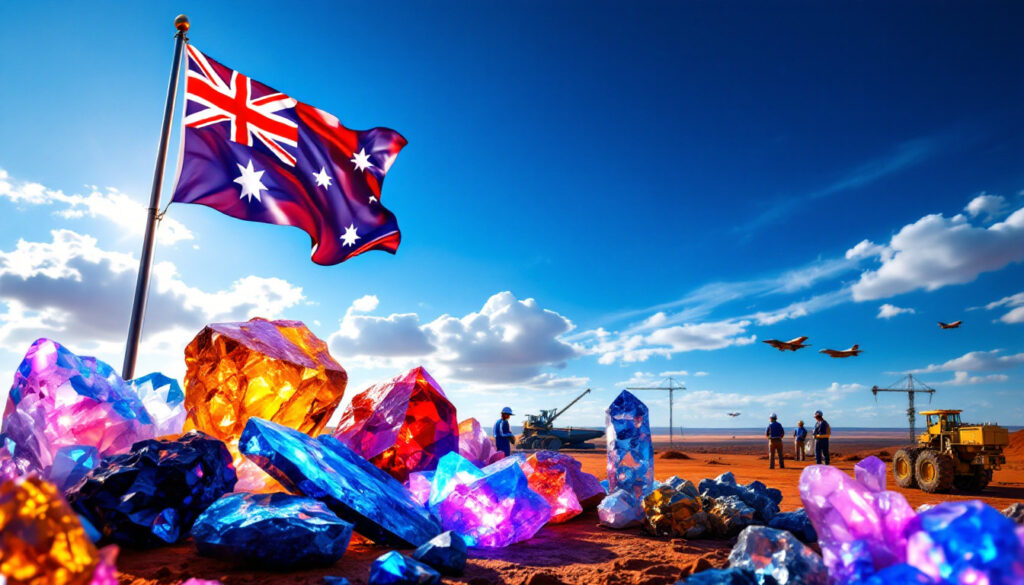What Are Defence-Critical Materials?
Definition and Strategic Importance
Defence-critical materials are essential minerals and metals required for manufacturing advanced military hardware and technology. These strategic resources form the backbone of modern defense capabilities, from jet engines to missile guidance systems.
In December 2024, NATO identified 12 key defence-critical raw materials: aluminium, beryllium, cobalt, gallium, germanium, graphite, lithium, manganese, platinum, rare earth elements, titanium, and tungsten. These materials are indispensable for radar technology, electronic warfare capabilities, and other advanced military applications.
The criticality of these materials stems not just from their technical applications but also from their supply vulnerability. Many defence-critical materials face concentration risk, with limited global sources and processing capabilities predominantly controlled by geopolitical competitors.
Australia's Critical Minerals Strategy
Australia maintains a comprehensive list of 31 critical minerals essential to modern technologies, economies, and national security. This strategic approach considers three key factors: geological potential within Australia, demand from strategic international partners, and vulnerability to supply chain disruption.
Key materials on Australia's critical minerals list include high-purity alumina, antimony, gallium, graphite, indium, lithium, manganese, nickel, rare earth elements (REEs), tungsten, and vanadium. Each of these plays a crucial role in defense applications, from aerospace components to electronic systems.
Australia's strategy recognizes that these minerals represent not just national security assets but also significant economic opportunities in a world increasingly concerned about secure supply chains.
Why Are Defence-Critical Materials Important to Australia?
National Security Considerations
Global supply chains for defence-critical materials face unprecedented vulnerabilities amid rising geopolitical tensions. China currently controls the lion's share of global processing capacity for many defence-critical materials, creating a strategic vulnerability for Western nations including Australia.
Between 2019 and 2024, China invested approximately US$34 billion in mining-related foreign direct investment projects worldwide, consolidating its dominance in critical mineral supply chains. This market concentration has raised serious concerns among defense planners in Australia and allied nations.
The strategic imperative to secure these resources has intensified as military technologies become increasingly sophisticated and mineral-dependent. For Australia, developing domestic supply chains represents both a national security imperative and a strategic advantage in alliance relationships.
Western nations, including Australia, are actively implementing policies to reduce dependency on Chinese supply chains for these vital materials. This shift creates both challenges and opportunities for Australia's mining sector and defense industry.
Economic Opportunities
Victoria's defence industry alone generates more than $8.4 billion annually and employs 24,000 people, highlighting the economic significance of this sector. The development of defence-critical materials represents a major growth opportunity within this ecosystem.
The Australian Government has introduced the Critical Minerals Production Tax Incentive (CMPTI), which provides a 10% tax benefit on relevant processing and refining costs. This incentive aims to stimulate investment in an industry seen as crucial for both economic and security reasons.
Australia's geological potential for many defence-critical materials creates significant export opportunities, particularly as allied nations seek trusted suppliers outside of Chinese control. Market analysts project that demand for some defence-critical minerals could increase by 400-600% over the next two decades as defense technologies advance.
Avalon 2025, the largest aerospace and defence expo in the Southern Hemisphere, showcases Australia's growing capabilities in this sector. The event highlights the integration between mining, processing, and defense manufacturing that makes Australia uniquely positioned in the critical minerals space.
Rare Earth Elements: The Foundation of Defence Technology
Strategic Applications of REEs
Rare earth elements include 17 elements with unique catalytic, metallurgical, nuclear, electrical, magnetic, and luminescent properties that make them irreplaceable in advanced defense systems. Despite their name, REEs are relatively abundant in the Earth's crust, but economically viable concentrations are rare.
Global demand for magnet REEs nearly doubled between 2015 and 2023 and industry projections suggest it could double again by 2050. Defense applications represent a significant and growing portion of this demand, particularly for heavy rare earth elements.
REEs are essential components in precision-guided munitions, lasers, radar systems, electronic warfare equipment, electric vehicles, batteries, and advanced electrical systems. The unique properties of elements like neodymium, praseodymium, dysprosium, and terbium make them crucial for high-performance permanent magnets used in defense applications.
Heavy rare earth elements (HREEs) like dysprosium, terbium, and yttrium are particularly crucial for defence applications due to their unique properties that enable technology miniaturization and performance in extreme conditions. These elements often face the most severe supply constraints.
Australian REE Projects
Critica's Jupiter Project represents one of Australia's most promising rare earth developments, with an inferred resource of 1.8 billion tonnes at 1,700ppm total rare earth oxide (TREO). The project's scale positions it as potentially globally significant for securing REE supply chains.
Victory Metals' North Stanmore Project demonstrates the economic viability of Australian REE development, with projections indicating a 31-year mine life, post-tax NPV of $1.212 billion, and internal rate of return (IRR) of 52%. These economics highlight the potential for Australia to develop commercially viable REE production.
ABx is developing production capabilities for mixed rare earth carbonate (MREC) with a distinctive focus on concentrations enriched in dysprosium and terbium—two of the most strategically valuable heavy rare earths for defense applications. This specialized approach targets the highest-value segment of the market.
American Rare Earths' Halleck Creek Project demonstrates the scalability potential in the sector, with an NPV10 of US$558 million that could potentially scale to US$1.171 billion with expanded production. The project highlights how initial developments can grow to meet increasing demand.
Ragnar Metals is exploring REE prospects in Sweden, a country ranked in the top 10 of the Fraser Institute's Annual Survey of Mining Investment Attractiveness. This international approach demonstrates how Australian companies are securing global rare earth reserves for these critical materials.
How Is Australia Addressing Manganese Supply?
Manganese's Role in Defence
Manganese stands as one of NATO's 12 officially designated defence-critical raw materials, highlighting its strategic importance to Western military capabilities. This often-overlooked mineral plays a crucial role in both structural applications and advanced battery technologies.
China currently dominates the global high purity manganese sulphate (HPMSM) supply chain, controlling approximately 93% of production. This market concentration represents a significant strategic vulnerability that Australia is uniquely positioned to address.
Manganese is essential for both traditional defense applications in steel alloys and emerging technologies like advanced batteries. Its dual-use nature makes it particularly valuable as defense systems increasingly rely on high-performance energy storage.
Diversification of manganese supply represents a strategic priority for Western nations, with Australia's high-grade deposits offering a geopolitically secure alternative to Chinese dominance. Industry analysts note that securing manganese supply chains has become a top priority for defense departments worldwide.
Australian Manganese Projects
Black Canyon has completed successful benchtop scale beneficiation testwork on samples from the W2 prospect at its Wandanya Project in Western Australia. Initial results indicate potential for producing battery-grade manganese from these deposits with competitive production costs.
Firebird Metals achieved a significant milestone with the granting of a mining lease for its Oakover Project, moving the company toward establishing low-cost manganese-based cathode material operations. The project's advancement represents a concrete step toward secured supply chains.
Firebird aims to secure a natural cost advantage in lithium-manganese-iron-phosphate (LMFP) cathode production, a technology with significant defense applications. Industry analysts note that LMFP cathodes could reduce battery costs by up to 30% while maintaining performance requirements for military applications.
What Other Critical Minerals Is Australia Developing?
Tungsten: High Heat Resistance
China controls approximately 85% of global tungsten supply, creating a strategic vulnerability for defense manufacturers requiring this vital metal. Tungsten's unique properties make it essentially irreplaceable in many defense applications.
As one of five refractory metals, tungsten exhibits extremely high resistance to heat and wear, with the highest melting point of any metal (3,422°C). This property makes it crucial for aerospace applications, armor-piercing ammunition, and radiation shielding.
Group 6 Metals is progressing the Dolphin Tungsten Mine in Tasmania, touted as the Western world's highest-grade tungsten deposit. With an average grade of 0.95% WO₃, the project represents a rare high-concentration resource outside Chinese control.
The Dolphin mine's history spans over 120 years, having operated intermittently until the 1990s when Chinese production dominance forced its closure. Its revival represents a strategic pivot toward secure supply chains rather than merely economic considerations.
Titanium: Aerospace Applications
Titanium's unique combination of strength, lightweight properties, and corrosion resistance makes it irreplaceable in aerospace applications, medical technology, and high-performance military equipment. The metal's strategic importance continues to grow as advanced defense systems require increasingly specialized materials.
McLaren Minerals is leveraging its recently acquired sulphate ilmenite project in Western Australia to address titanium supply chain vulnerabilities. The company's 6,000-meter aircore drilling program at the McLaren Titanium Project represents a significant exploration investment.
McLaren's strategic transition from silica sands to heavy mineral sands specifically targeting titanium minerals demonstrates how Australian companies are pivoting toward defence-critical materials in Australia. Industry experts note that titanium's aerospace applications make it particularly valuable in the current geopolitical environment.
Gallium: Advanced Electronics
Gallium is essential for advanced radar systems, missile guidance, and electronic warfare capabilities due to its unique semiconductor properties. Its role in gallium nitride (GaN) technology represents one of the most significant advances in defense electronics of the past decade.
China's near-monopoly position, accounting for more than 98% of global gallium production, creates an acute strategic vulnerability. Export restrictions imposed by China in 2024 have already disrupted Western defense manufacturing, highlighting the urgency of supply diversification.
Victory Metals has demonstrated the potential for integrated production by successfully extracting gallium in its final mixed rare earth carbonate product from its North Stanmore project. This approach to co-production could significantly improve project economics while addressing critical supply gaps.
How Is Australia Supporting Critical Minerals Development?
Government Initiatives
The Australian Government introduced landmark legislation in November 2024 providing tax incentives specifically targeting critical minerals production. This policy shift recognizes the strategic rather than purely economic value of these resources.
The Critical Minerals Production Tax Incentive (CMPTI) offers 10% of relevant processing and refining costs as a tax benefit, directly addressing the economic challenges of establishing sovereign capability in these sectors. This approach has been praised by industry analysts as a model for other Western nations.
Western Australia led a delegation of 34 local SMEs across defence, aviation, aerospace, and space markets at Avalon 2025, demonstrating the integration between mining and defense industries. The cross-sector approach highlights Australia's whole-of-government strategy toward critical minerals.
The Victorian Government has implemented targeted policies backing the defence industry through its Economic Growth Statement, creating an ecosystem where critical minerals development connects directly to manufacturing capabilities. This integrated approach provides advantages over competitors focusing solely on extraction.
Industry Collaboration
Avalon 2025 provided vital opportunities for Australia's defence businesses to connect with global industry leaders and showcase domestic capabilities. The event highlighted the growing integration between critical minerals and defense manufacturing sectors.
Companies like Wedgetail Aerospace and Innovaero showcased defense drone technology and remote piloted aircraft systems that rely heavily on critical minerals, demonstrating the end-use applications driving demand growth. This connection between mining and final defense applications creates value chain opportunities.
Junior exploration companies are increasingly focusing their efforts specifically on defence-critical materials, adjusting exploration priorities to align with national security requirements rather than traditional market forces alone. This strategic pivot represents a significant shift in the industry's approach.
Strategic partnerships across technology, defense, and energy sectors are being developed with unprecedented speed, creating integrated supply chains from mine to military application. Industry experts note that these collaborative models represent a new paradigm in critical minerals grant programs and development.
FAQs About Defence-Critical Materials in Australia
What makes a mineral "defence-critical"?
Defence-critical materials are essential for manufacturing advanced military hardware and technology. NATO has identified 12 key materials that form the backbone of military equipment, including jet engines, missile guidance systems, and electronic warfare capabilities. The designation considers both technical necessity and supply vulnerability.
Why is China's dominance in critical minerals concerning?
China controls the majority of global processing capacity for many defence-critical materials, creating supply chain vulnerabilities for Western nations. Between 2019 and 2024, China invested approximately US$34 billion in mining-related foreign direct investment projects to secure access to critical minerals. This concentration creates both economic leverage and potential security vulnerabilities during conflicts.
What tax incentives does Australia offer for critical minerals production?
In November 2024, the Australian Government introduced the Critical Minerals Production Tax Incentive (CMPTI), which provides a 10% tax benefit on relevant processing and refining costs for the nation's list of 31 critical minerals. This incentive specifically targets the processing and refining stages where China currently dominates global capacity.
Which rare earth elements are most valuable for defence applications?
Heavy rare earth elements (HREEs) like dysprosium, terbium, and yttrium are particularly valuable for defence applications due to their use in high-performance magnets, lasers, and aerospace components. These elements often command prices 5-10 times higher than light rare earths due to their scarcity and strategic importance.
How significant is Australia's rare earth element potential?
Australia has at least 4% of global REE reserves and is positioned to capitalize on the growing market. Companies like Critica, Victory Metals, ABx, and American Rare Earths are developing significant REE projects with billion-dollar potential. Australia's combination of geological endowment, processing expertise, and geopolitical stability makes it uniquely positioned in global REE markets, supported by initiatives like the government's boost to Iluka's rare earth refinery and expanding lithium ambitions.
Want to Identify the Next Major Mineral Discovery on ASX?
Discover how you can gain early insights into significant ASX mineral discovery announcements with Discovery Alert's proprietary Discovery IQ model, helping you stay ahead of the market with actionable investment opportunities in defence-critical minerals. Explore historic returns of major mineral discoveries at Discovery Alert's discoveries page and position yourself for potential investment success.




